
Lilium is a genus of herbaceous flowering plants growing from bulbs, all with large prominent flowers. They are the true lilies. Lilies are a group of flowering plants which are important in culture and literature in much of the world. Most species are native to the Northern Hemisphere and their range is temperate climates and extends into the subtropics. Many other plants have "lily" in their common names, but do not belong to the same genus and are therefore not true lilies.
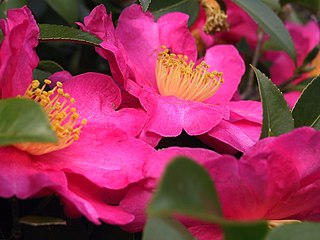
Camellia is a genus of flowering plants in the family Theaceae. They are found in tropical and subtropical areas in eastern and southern Asia, from the Himalayas east to Japan and Indonesia. There are more than 220 described species. Camellias are popular ornamental, tea and woody-oil plants that have been cultivated throughout the world for centuries. To date, over 26,000 cultivars, with more than 51,000 cultivar names including synonyms, have been registered or published.

Primula is a genus of herbaceous flowering plants in the family Primulaceae. They include the primrose, a familiar wildflower of banks and verges. Other common species are P. auricula (auricula), P. veris (cowslip), and P. elatior (oxlip). These species and many others are valued for their ornamental flowers. They have been extensively cultivated and hybridised. Primula are native to the temperate Northern Hemisphere, south into tropical mountains in Ethiopia, Indonesia, and New Guinea, and in temperate southern South America. Almost half of the known species are from the Himalayas.

A daylily or day lily is a flowering plant in the genus Hemerocallis, a member of the family Asphodelaceae, subfamily Hemerocallidoideae, native to Asia. Despite the common name, it is not in fact a lily. Gardening enthusiasts and horticulturists have long bred daylily species for their attractive flowers. Thousands of cultivars have been registered by local and international Hemerocallis societies. Daylilies are perennial plants, whose name alludes to its flowers, which typically last about a day.

Acorus calamus is a species of flowering plant with psychoactive chemicals. It is a tall wetland monocot of the family Acoraceae, in the genus Acorus. Although used in traditional medicine over centuries to treat digestive disorders and pain, there is no clinical evidence for its safety or efficacy – and ingested calamus may be toxic – leading to its commercial ban in the United States.
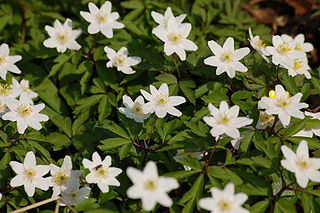
Anemonoides nemorosa, the wood anemone, is an early-spring flowering plant in the buttercup family Ranunculaceae, native to Europe. Other common names include windflower, European thimbleweed, and smell fox, an allusion to the musky smell of the leaves. It is a perennial herbaceous plant growing 5–15 cm (2–6 in) tall.

Berberis, commonly known as barberry, is a large genus of deciduous and evergreen shrubs from 1–5 m (3.3–16.4 ft) tall, found throughout temperate and subtropical regions of the world. Species diversity is greatest in South America and Asia; Europe, Africa and North America have native species as well. The best-known Berberis species is the European barberry, Berberis vulgaris, which is common in Europe, North Africa, the Middle East, and central Asia, and has been widely introduced in North America. Many of the species have spines on the shoots and all along the margins of the leaves.

Hosta is a genus of plants commonly known as hostas, plantain lilies and occasionally by the Japanese name gibōshi. Hostas are widely cultivated as shade-tolerant foliage plants. The genus is currently placed in the family Asparagaceae, subfamily Agavoideae, and is native to northeast Asia. Like many "lilioid monocots", the genus was once classified in the Liliaceae. The genus was named by Austrian botanist Leopold Trattinnick in 1812, in honor of the Austrian botanist Nicholas Thomas Host. In 1817, the generic name Funkia was used by German botanist Kurt Sprengel in honor of Heinrich Christian Funck, a collector of ferns and alpines; this was later used as a common name and can be found in some older literature.

Camellia japonica, known as common camellia, or Japanese camellia, is a species of Camellia, a flowering plant genus in the family Theaceae. There are thousands of cultivars of C. japonica in cultivation, with many colors and forms of flowers. Despite its common name, it is native to China, not Japan. The cultivation of Camellia japonica also started in China. Its widespread cultivation can be traced back to the Song Dynasty, when 15 varieties of Camellia japonica were recorded in literature. It was later introduced to Japan. It grows in forests, at altitudes of around 300–1,100 metres (980–3,600 ft).

Heuchera is a genus of largely evergreen perennial plants in the family Saxifragaceae, all native to North America. Common names include alumroot and coral bells.

Berberis thunbergii, the Japanese barberry, Thunberg's barberry, or red barberry, is a species of flowering plant in the barberry family Berberidaceae, native to Japan and eastern Asia, though widely naturalized in China and North America, where it has become a problematic invasive in many places, leading to declines in species diversity, increased tick habitat, and soil changes. Growing to 1 m tall by 2.5 m broad, it is a small deciduous shrub with green leaves turning red in the autumn, brilliant red fruits in autumn and pale yellow flowers in spring.

Camellia sasanqua, with common name sasanqua camellia, is a species of Camellia native to southern Japan. It is usually found growing up to an altitude of 900 m (3,000 ft).

Camellia reticulata is a species of flowering plant in the tea family Theaceae, native to southwestern China, in Yunnan and Sichuan Provinces.

Jasminum polyanthum, the many-flowered jasmine, pink jasmine, or white jasmine, is a species of flowering plant in the olive family Oleaceae, native to China and Myanmar. A strong evergreen twining climber, it is especially noted for its abundant, highly fragrant pink to white flowers.
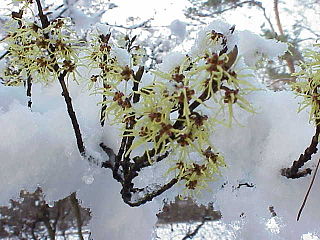
Hamamelis mollis, also known as Chinese witch hazel, is a species of flowering plant in the witch hazel family Hamamelidaceae, native to central and eastern China, in Anhui, Guangxi, Hubei, Hunan, Jiangxi, Sichuan, and Zhejiang.

Buddleja madagascariensis, the smokebush or Madagascan butterfly bush, is a species of flowering plant in the figwort family Scrophulariaceae. It is a substantial evergreen shrub with fragrant yellow flowers through autumn and winter.

Pachysandra axillaris is a species of plant in the family Buxaceae. In its native China, it is known as 板凳果.
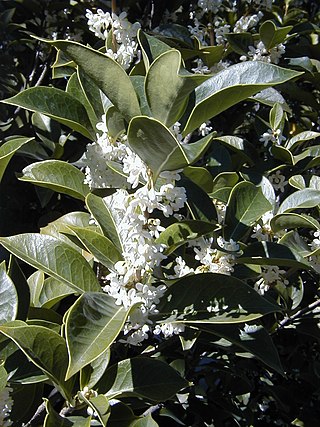
Osmanthus armatus, also known by the common name devil wood or Chinese vernacular name 红柄木犀 is a species in the genus Osmanthus in the family Oleaceae. It is native to China, specifically the west or central and southeast.

Stachyurus salicifolius, also known by the Chinese vernacular name 柳叶旌节花, is a species in the genus Stachyurus in the family Stachyuraceae. It is native to China, specifically Chongqing, Sichuan, and northeast Yunnan.
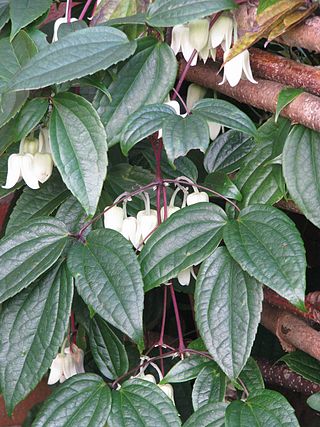
Clematis urophylla is a species of flowering plant in the genus Clematis in the family Ranunculaceae. It is native to China, specifically the southwest or south central and southeast. It can be found wild in the provinces of Guangdong, Guangxi, Guizhou, Hubei, Hunan, and Sichuan.
























